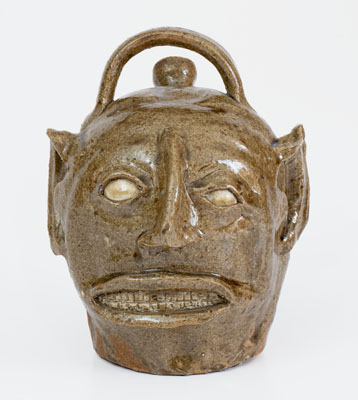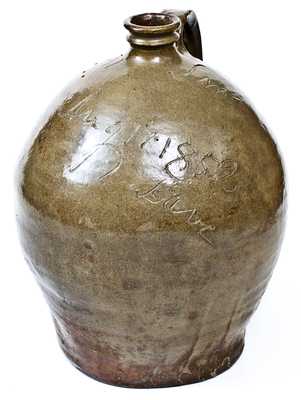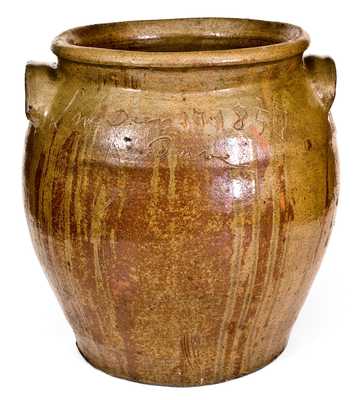Exceedingly Rare and Important Five-Gallon Alkaline-Glazed Stoneware Jar, Dated "aug 3d 1836," attributed to Harry at Pottersville Stoneware Manufactory, Edgefield District, SC origin, 1836, highly-ovoid jar with dramatically-swelled shoulder, flattened lug handles, and broad opening with thin, semi-rounded rim, the surface dipped in a gray-green alkaline glaze. Study of the surface indicates the jar was dipped multiple times in its glaze, both in a downward fashion and upside down, as indicated by upward vertical runs at the vessel's midsection. The front shoulder bears the incised date, "aug 3d 1836," and the reverse shoulder features five short, diagonally-incised slash marks followed by a single longer slash. This recently-attributed jar survives as one of only three inscribed pieces known by the potter, Harry, an enslaved African-American craftsman at Pottersville. One jar measuring fifteen gallons and inscribed, "Harry / July 38(?)," is illustrated in Toussaint, "Edgefield District Stoneware: The Potter's Legacy," Journal of Early Southern Decorative Arts, Vol. 42-43, 2021-2022. A second, inscribed "Harry," measures four gallons and was sold in Crocker Farm, Inc.'s Spring 2021 auction, lot 53. All three are inscribed in the same distinctive hand. Harry is remarkably well documented in the historical record as a "turner" at the prolific Pottersville Stoneware Manufactory founded circa 1815 by Abner Landrum. As the founding stoneware shop of the Edgefield pottery tradition and the one credited with introducing alkaline glaze to the United States, it is difficult to overstate its importance to the development of America's ceramic craft as a whole. Pottersville is meanwhile the shop that began the career of David Drake, whose name "Dave" appears in an 1818 mortgage associated with the manufactory in a manner similar to the pictured documents referencing Harry. Harry first appears in a January 1839 indenture between well-known Edgefield potter Collin Rhodes and John H. Hughes, a man who took over Rhodes' share of an interest in Pottersville. This document references both an "old Harry" and a "young Harry" associated with the operation; whether the "Harry" of this jar is the older or younger Harry is up to speculation, but documents soon show a single Harry working as a key potter at Pottersville: August 1839 and May 1840 references to Harry appear in the ledger of the aforementioned Hughes and Nathaniel Ramey, partners in the Pottersville Stoneware Manufactory as well as a local general merchant concern. In November 1840, James W. Gibbs sold Jasper Gibbs three-fourths of his ownership of Harry, along with other shares of Pottersville property, the pair also being partners in the shop at that time. A March 1842 mortgage again references Harry in association with the Pottersville Stoneware Manufactory; as in previous documents, it identifies other enslaved workers at the pottery, in this case Abram and Daniel (fellow turners with Harry) and "old Tom" (a wagoner). A notice in the Edgefield Advertiser dated February 21, 1843 is the last identifiable reference in the historical record to Harry. In it, Jasper Gibbs & Co. announced that the firm would be selling at auction "our entire Pottersville property ... consisting of four Negroes, viz. three Turners and one Wagoner" along with a "stock of Stone Ware" and other property. (The Pottersville shop was acquired by future Governor of South Carolina Francis W. Pickens sometime circa 1844-1850 under whose ownership, according to Cinda K. Baldwin's Great & Noble Jar, "the operation evidently declined.") The jar offered in this auction expands our understanding of an important figure in the story of Edgefield stoneware, building on a small but growing body of this potter's work and helping to identify his own distinctive style. This example displays what can be dubbed Harry traits in its flattened rim and handles. It also showcases his high level of proficiency as a potter in its thin-walled construction and stately, swell-bodied form, including an impressive circumference of 46 1/2 inches. Of interesting note, the jar was produced the same year as David Drake's iconic "Catination" jar. According to Goldberg and Witkowski's Ceramics in America 2012 article, "Beneath His Magic Touch: The Dated Vessels of the African-American Slave Potter Dave," the year, 1836, saw possible growth in the number of dated vessels Drake was producing; eight are documented as of the writing of the article, two of which included poems. Perhaps Harry's jar is further evidence of some sort of change at Pottersville during this year or emblematic of artistic influence between these two potters. At any rate, the discovery of a third Harry jar with incised inscription suggests that he may have actually inscribed his work with some frequency, and further highlights that Drake was not unique in this regard. Provenance: From a fifty-year SC collection. Very nice condition with a thin Y-shaped crack from rim on reverse, descending to shoulder area, a faint 3 1/4" surface line from rim on far right side jar's front, a small base chip, and extremely minor base wear. H 15" ; Diam. (at rim) 10" ; Circum. 46 1/2".






















